
The Spies were in Seattle last week and just by coincidence ran into the VW ad agency, shooting their latest set of newspaper and magazine spreads.
We thought you would enjoy the photos (shot outside the cool new Seattle public library) and also the latest info on the recently announced Phaeton V6 3.0L TDI.
New 3.0l TDI with 332 lb.ft. of torque
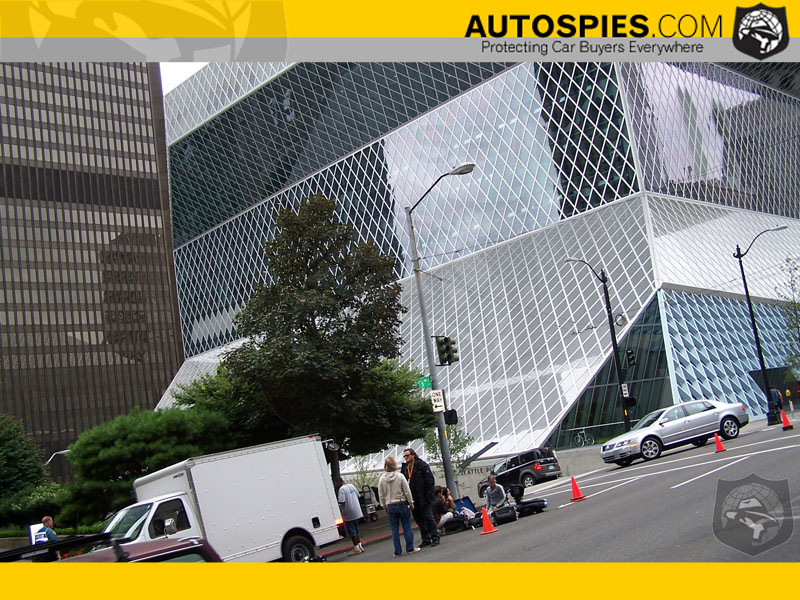
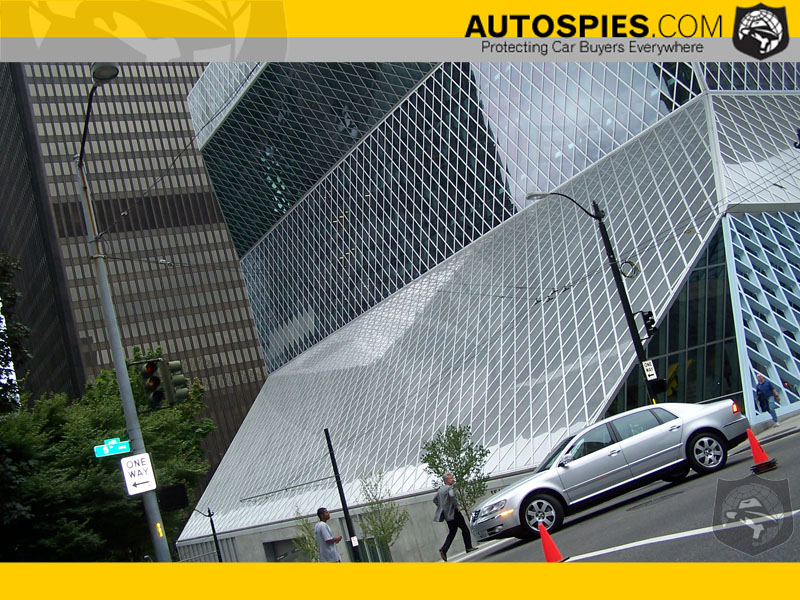
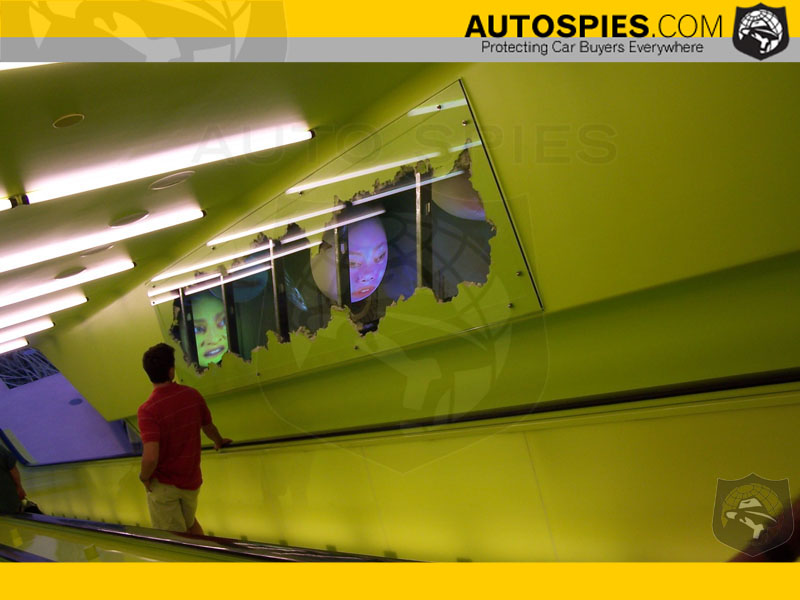
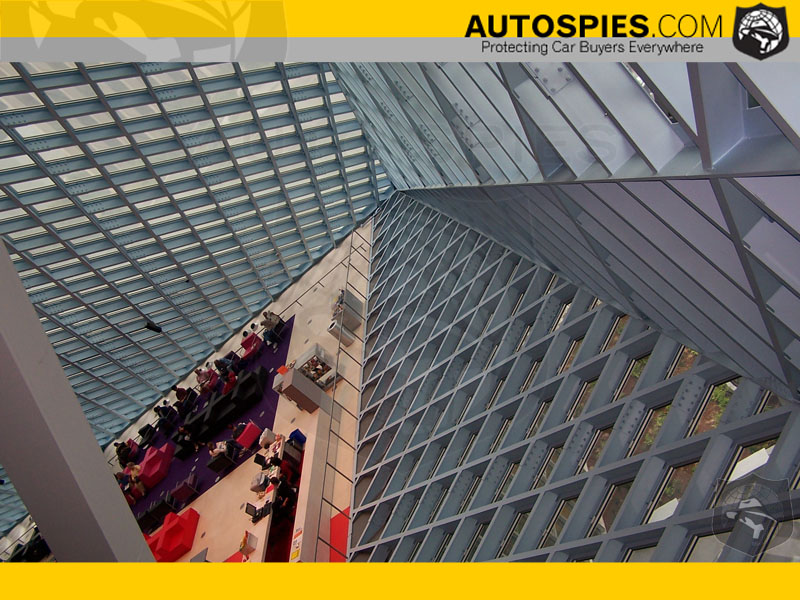
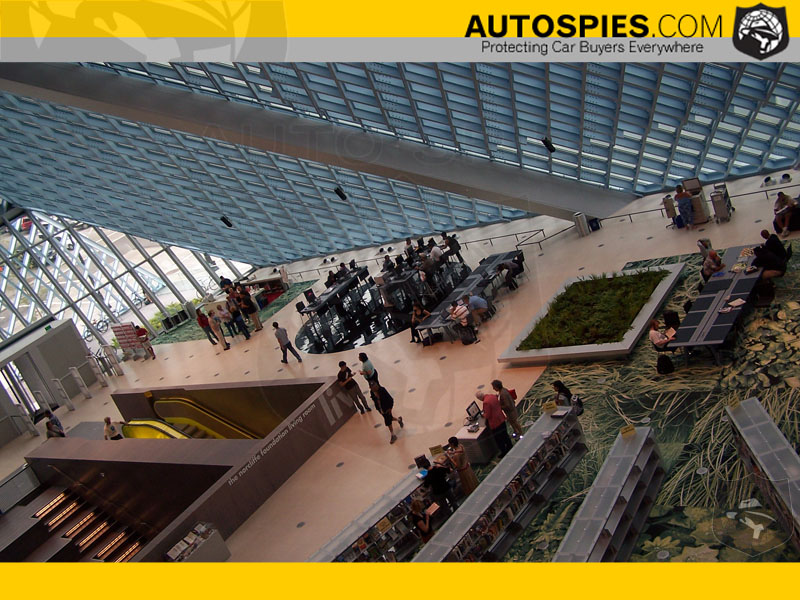
Volkswagen is widening the range of engine options on the Phaeton in November 2004 with an additional high-tech turbo-diesel, the V6 TDI (= turbo-diesel injection) 3.0 with state-of-the-art piezo technology. This direct-injection 2967 cc engine develops an impressive 165 kW / 225hp and produces its maximum torque of 450 newton metres (332 lb-ft) almost from a standing start (from 1400 up to 3250 rpm) . The Phaeton V6 TDI 3.0 is also one of the first vehicles in the top-price segment to come even in its standard form with a diesel particle filter (DPF), so this luxury car meets the EU-4 emission standard.
All versions of the Phaeton V6 TDI 3.0 have all-wheel drive (4MOTION), and with its 6-speed automatic (Tiptronic) gearbox it can reach a top speed of 234 km/h (145 mph) and only takes 8.8 seconds to sprint from 0 to 100 km/h (0-62 mph). On the other side of the coin it achieves a fuel consumption of only 9.6 litres/100 kilometres (24.5 mpg).
Plenty of push at low revs: One of the most important characteristics of the new V6 TDI is the power it develops at low engine speeds. This is one of the special attractions of the TDI and differentiates it clearly from all 6-cylinder petrol engines of similar capacity. Even at 220 km/h (137 mph) this engine is still running at less than 4000 rpm. At motorway speeds of 130 km/h (80 mph) and in sixth gear it turns over at a gentle 2200 rpm. On a country road at 100 km/h (62 mph) and also in sixth gear the engine speed goes down to 1700 rpm. Because of the high torque at low revs, the six-speed automatic gearbox can extremely often be left in top gear without any risk of stalling or dropping into the turbo lag zone - since there is none.
V6 TDI 3.0: The technology of the new 6-cylinder in detail
Compact and light: The Phaeton's new V6 TDI engine is extremely compact, with a length of only 440 mm. A 90° V-angle is the distinguishing feature of the highly rigid but still very light cylinder crankcase; it is cast in vermicular graphite cast iron, which delivers all the rigidity of grey cast iron at 15 percent less weight. This engine weighs a mere 220 kilos (485 lbs.), the distance between cylinder centers is 90 mm and its compression ratio is 17:1.
Runs as quietly as a petrol engine: The 24 valves of this 6-cylinder engine are actuated by low-friction roller finger followers with hydraulic valve-play compensation, a technique that, like the piezo technology, contributes to reducing consumption and exhaust emissions substantially. The engine's acoustics and quiet-running characteristics are also outstanding and are certainly comparable to those of a 6-cylinder petrol engine. Combined with the new common rail system and the highly rigid construction of the cylinder crankshaft housing, the use of roller finger followers also reduces motor noise levels perceptibly. In detail, together with the stress-free and almost play-free camshaft drive gears, they make it possible to reduce the mechanical noise of the valve drive - a fundamental prerequisite for the excellent quiet-running properties of the V6 TDI 3.0, which bear comparison with those of a 6-cylinder petrol engine.
1600 bar (23,206 psi) injection pressure: A state-of-the-art common rail system, the Bosch CRIP II+, is responsible for fuel-air mixing. It consists of a high-pressure pump, which can produce an injection pressure of up to 1600 bar (23,206 psi), one distribution rail per cylinder bank, the low-pressure system with a fuel pump and a filter, the piezo injectors and an electronic control unit complete with sensors. This is a very high injection pressure for a common rail engine and means that the fuel can be sprayed more finely, which also makes for the best possible mixture and for more efficient combustion. The results can be felt and measured: output (in kW or h.p.) and torque (in Nm) rise just as significantly as consumption and exhaust emissions fall.
Piezo technology instead of magnetic valves: One key function within this newly designed common rail system is taken over by the piezo injectors. The background to this is that, up to now, electronically controlled magnetic valves have been used in the injectors to control the timing and the duration of injection into each cylinder. The job of the magnetic valves is now handled in the V6 TDI 3.0 and, for the first time ever, by the piezo inline injectors, which operate far faster.
In these new injectors, the injection valves are in turn controlled by units referred to as piezo actuators. Each of these consists of piezo crystals that change their structure and enlarge under electrical voltage. This results in a minimal geometrical change that, with the assistance of a hydraulic element, mechanically actuates the aperture of the injection nozzle needle.
Faster and lighter: Piezo technology has a large number of practical advantages to offer. The electronically controlled piezo actuator switches five times more quickly that a conventional magnetic valve. Because it is integrated directly into the injector, the movement is transferred directly to the nozzle needle without any mechanical element or any friction, and the moving mass of the nozzle needle has been reduced by 75 percent, from 16 to only 4 grams. Compared with magnetic valves, piezo technology also delivers double the nozzle needle speed. The actual injection goes through a 7-hole nozzle; it contributes to homogenous fuel distribution in the combustion chamber and to reducing emissions by achieving more efficient combustion.
Four injections in each stroke: Because of these technical conditions it is possible to vary the number of injection cycles in order ideally to match the immediate operating conditions. In the case of the new V6 TDI 3.0, Volkswagen uses up to four injections per working stroke: in addition to the main injection there is a double pre-injection in the low rev range and a single one at medium revs, and there is also a single post-injection at engine speeds up to about 2500 rpm. This sequence of injections guarantees on the one hand the best possible emissions behaviour and on the other hand "softer” combustion, which results in extremely agreeable engine noise levels. The V6 TDI 3.0 can claim a leading position in this respect, and in the passenger compartment of the Phaeton it will hardly be perceived as a diesel engine; on the contrary, the engine noise levels and quiet-running properties are exactly the same as those of a 6-cylinder petrol engine.
Centrally integrated turbocharger, two intercoolers: In the interests of making the most economical use of space, the turbocharger is located centrally within the V-angle of the engine. In order to achieve the best possible efficiency from the turbocharger, the temperature of the intake air is effectively lowered through two parallel intercoolers with a minimal loss in pressure. The variable turbine geometry of the exhaust turbocharger is controlled in the new V6 TDI 3.0 by aunit referred to as an electric actuator, which enables the guide blades to be set more quickly and precisely. At low engine speeds in particular this results in a faster build-up of turbocharger pressure and thus contributes to a significantly better response behaviour. This direct implementation of acceleration commands is effectively supported by the optimised shapes of the compressor and turbocharger fans.
Variable intake: There are also three infinitely variable swirl flaps integrated directly into the air intake with which the air movement can be adjusted to suit the immediate engine speed and load. The background to this is that a high degree of swirl at a low engine load optimises combustion just as, conversely, low swirl does at a high motor load. This means in practice that a closed channel at a low load increases the swirl whilst an open channel at a high load make it possible to fill the cylinders to a high level.
Exhaust gas recirculation: The emissions of the V6 TDI are almost entirely reduced back at the combustion stage. Any exhaust gases that are left are rendered harmless in the next stage. One example is exhaust gas recirculation. The exhaust manifold is designed with double walls and is air-gap insulated, so that the exhaust gases can be sent for treatment without any appreciable heat loss. Effective cooling is necessary, on the other hand, for the actual exhaust recirculation so that, for instance, the emissions of NOx and particles can be effectively reduced. The exhaust gas therefore passes through an exhaust gas recirculation (EGR) cooler with a water through-flow; this is controlled in relation to temperature and load and located in the internal V-angle of the engine, thus achieving an optimum economy of space. In the cold-start phase, however, the exhaust gases "squeeze through” via a bypass channel ahead of the cooler so that the catalytic converters can work more quickly at their ideal operating temperature. Once the engine and the catalytic converters have warmed up the exhaust gas comes directly back into the area of the EGR cooler.
Catalytic converter and DPF: The exhaust gas is cleaned by a pre-converter located close to the engine (and near to the turbocharger) and the main catalytic converter in the under-floor. Soot particles are then screened out by a diesel particle filter (DPF), a standard feature on the Phaeton V6 TDI 3.0.
Diesel particle filters generally serve the purpose of picking up and eliminating diesel soot before it can be sent out into the environment with the exhaust gases. A system is in use on the Phaeton V6 TDI 3.0 that uses the latest state-of-the-art technology. It is called the "Catalysed Soot Filter” (CSF) and uses a filter coating containing stainless steel that works in two different ways: passive regeneration, in which the soot accumulating in the catalytic converter is converted slowly and gently into CO2, a process that occurs at temperatures between 350 °C and 500 °C and runs continually without any special effort, mainly on long stretches of motorway driving; and active regeneration, during longer period of operation on low load such as in big cities, when the exhaust temperature is actively raised to about 600 °C every 1000 to 1200 kilometres for additional filter regeneration. The particulates accumulating in the filter are burnt off at this temperature.
Motor management: All these processes have to be perfectly controlled and monitored. In the Phaeton V6 TDI 3.0 this task is handled by the highly efficient Bosch EDC 16 engine management system, which coordinates the fuel quantities and the start of fuel injection, the turbocharger pressure and the exhaust recycling. The electronic system in the Phaeton also provides for a push-button engine start and thus for the use of the optional keyless access unlocking and starting system. To ensure that this startup works as quickly in the winter as it does in the summer, the engine also has a high-speed preheating system with ceramic glow plugs.
4MOTION + air suspension
The highest levels of active safety and comfort as a standard feature
The only luxury-class car in the world with all-wheel drive on all variants
Hardly any other luxury-class car offers such a convincing range of active safety reserves as the Phaeton from Volkswagen. This is because all versions of this car are equipped in their standard form with the combination of all-wheel drive and air suspension. Take the all-wheel drive as an example: under the designation of 4MOTION this system guarantees not only excellent driving dynamic and comfort even in the worst of weather but also the highest possible level of active safety. Take 4-corner air suspension as another example: it has continually adjustable damping control (CDC), provides perfect comfort on all roads and lowers the bodywork when the car reaches a speed of 140 km/h (87 mph). This optimizes road-holding and lowers average fuel consumption.
4MOTION: The technology of permanent all-wheel drive
Variable power distribution: 4MOTION, in comparison with rear-wheel drive, mainly offers its substantial advantages in the fields of traction and handling. In critical load-changing situations in particular, all-wheel drive displays its advantages almost independently of control systems such as the ESP that comes as a standard feature on the Phaeton. Power is distributed to all four wheels through the 4MOTION drive in a fully variable manner, according to the degree of slip, so power distribution is always varying. As a result, the best possible traction and lateral forces are maintained constantly on each wheel.
Power distribution via a torsion differential: The key function of power distribution is handled by a torsion differential, which reacts to the slightest deviations in rate of rotation. Because the Phaeton has this differential integrated into the 4MOTION drive and a standard power distribution of 50:50 between the front and rear axles, it can be regarded as a genuine all-wheel-drive car. Another highly innovative piece of technology is the final drive developed specially for the Phaeton. It can handle an extraordinarily high gear input torque of up to 1000 newton metres (738 lb-ft) and an engine output of up to 450 kW / 612 h.p.
Suspension: 4-corner air suspension technology
The fact that Volkswagen has been able to the achieve excellent driving safety and highly dynamic performance in the Phaeton while at the same time providing extremely good comfort is due to its air suspension - another standard feature - with four-link geometry on the front axle and trapezoidal wishbone suspension at the back.
Comfortable and sporty: The automatic levelling system in the 4-corner air suspension with its continually variable damping control permits a soft suspension set-up that operates independent of load and for high levels of comfort. This design concept has a beneficial effect on driving stability and also enables the car to be deliberately lowered at high speeds in order to reduce fuel consumption as well as pitching movements. At the same time, the air suspension optimises road-holding on poor roads.
Infinitely variable: Because of the physical behavior of the air suspension, the spring rates and the ground clearance of the car are adjusted automatically to the immediate load, so at the same time it also takes over the function of a conventional self-levelling system. This in turn means that comfort remains at the same high level in all load conditions. In addition to this, the load-dependent changes in the dynamic forces of travel are reduced. Because the damping effect can be infinitely varied, comfort and safety in driving are appreciably improved and even extreme handling situations can be managed with the precisely coordinated damping regulating system.
Three height levels: Basically the air suspension system on the Phaeton provides three different height levels: normal, high (25 mm above normal) and low (15 mm below). The low level is automatically set as a factor of speed in order to optimise roadholding and fuel consumption at speeds of more than 140 km/h. It goes without saying that the driver can also intervene manually in the suspension setting with a choice of two heights, normal and high and four damping settings: comfort, basic, sport and sport 2.
Skyhook: The actual damping regulation is based on the so-called "skyhook” principle, which in general terms minimises the initial acceleration, guarantees a constant level regardless of road conditions, and thus provides both a special level of comfort and the best possible grip for the tires. The combination of the 4MOTION all-wheel-drive and air suspension systems with electronic damping control represents the ultimate state-of-the-art technology that can currently be achieved - an exact reflection of the basic concept behind the Phaeton.
Series equipment :
- 4-zone Climatronic works without drafts and provides four temperature zones.
- 190 watt audio system and CD changer likewise standard features
The extensive range of features on even the standard version of the Phaeton V6 TDI 3.0 also includes technology highlights such as air suspension and continual speed-dependent damping control, permanent all-wheel-drive (4MOTION), a six-speed automatic gearbox (Tiptronic) and the 4-zone Climatronic system that works without causing a draft. Here is an overview of the standard equipment:
Exterior equipment:
- Heat-insulated glass, green, tinted rear window
- Grey shading in the upper part of the windscreen
- Light alloy wheels, 7½ J x 17 "Inspiration” with locking wheel nuts, tyres 235/55 R 17
- Rear lights with LED technology
- Headlamps with Xenon dipped beams and halogen main beams
- Chromium-plated bumpers, decorative strips and door and window trim strips.
Interior equipment:
- Sunglasses compartment in roof console (not in combination with sliding roof)
- "Eucalyptus” wood trim for instrument panel, upper door trim, top of central console and front cup holders.
- Seat covers in "Pearl” fabric design
- Front seats with 12-way electric adjustment including lumbar supports (5-seater)
- Central arm rests, front and back
- Short central console
- Multi-function leather steering wheel (4-spoke)
- Non-smoker version: storage boxes instead of ashtrays
- Stainless steel pedal plates
- Gear lever knob in leather/wood combination
- Textile foot mats, front and back
Safety features:
- Airbags: Front airbags for driver and front-seat passenger (front-seat passenger's airbag can be deactivated), side airbags for driver, front-seat passengers and rear-seat passengers, head airbags for front-seat and rear-seat passengers
- All-wheel drive (4MOTION)
- Three-point automatic safety belts front and back, height-adjustable at the front.
- Electronic Stability Programme (ESP) including ABS/EDS, MSR/ASR and Braking Assistant)
- Belt-tightener at front and rear seats for outer passengers
- Isofix attachments (for fastening two child seats at the rear)
- Child safety locks for rear doors, operable electrically by the driver
- Headrests (5), active at the front in order to avoid whiplash injuries
- Fog lamps
- Automatic door locking when vehicle begins to move, can be regulated and switched off according to the vehicle's speed
- First-aid kit and warning triangle
- Fastening eyes (4) in the luggage compartment, chromium-plated
Functional equipment:
- 4-zone Climatronic with air-quality / anti-condensation sensor and 4-zone temperature regulator, indirect ventilation
- Analogue clock on instrument panel
- Audio system, 8/10: 8-channel analogue amplifier with 10 loudspeakers, approx. 190 watts, CD changer for 6 CDs with cushioned storage in glove compartment
- Exterior mirrors, synchronously adjustable and separately heated, aspherical on the driver's side
- Six-speed automatic gearbox (Tiptronic)
- Electric windows at front and rear
- Cruise control
- Infotainment system in the instrument panel with full-colour 7-inch display
- Automatic dipping interior mirror
- Steering column adjustable in rake and reach
- Exterior lighting: courtesy/warning lights on all doors, surround lights, sentry function.
- Interior lights: footwell lighting front and rear, reading lamps front and rear, indirect interior / instrument panel lighting
- Air suspension with continuous speed-dependent electronic damping regulation, comfort and sport recognition, self-levelling
- Vanity mirror in sun visor, illuminated
- Multi-function display with 5-inch colour display
- Multi-purpose rear window aerial
- Rain sensor
- Windscreen wash-wipe system
- Servotronic steering, speed-dependent regulator
- Tire mobility set: 12 V compressor and tyre sealant
- Central locking with radio remote control, interior switch, with crash sensor for automatic opening
All data and equipment levels shown in this press release apply to model ranges destined for the German market. In other countries deviations may apply. Subject to amendment. Errors excepted.